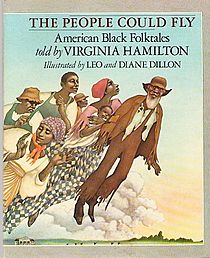The People Could Fly facts for kids
 |
|
| Author | Virginia Hamilton |
|---|---|
| Illustrator | Leo and Diane Dillon |
| Country | United States |
| Language | English |
| Subject | Children's literature, Slavery in the United States, Folklore |
| Published | 1985 |
| Publisher | Knopf |
| Media type | Print (hardback & paperback) |
| Pages | 178 |
| ISBN | 9780394869254 |
| OCLC | 975841967 |
The People Could Fly: American Black Folktales is a special book published in 1985. It's a collection of twenty-four amazing folktales that were retold by the famous author Virginia Hamilton. The beautiful pictures inside were created by Leo and Diane Dillon.
This book brings together many different kinds of stories. You'll find animal tales where animals talk and act like people, including clever trickster characters. There are also magical fairy tales and exciting supernatural tales. A very important part of the book includes stories about enslaved Africans, sharing their experiences and hopes.
Awards and Recognition
The People Could Fly is a highly praised book that has won several important awards. These awards show how much people loved the stories and the artwork.
Honors for the Book
- In 1985, it was named a Horn Book Fanfare Book. This means it was chosen as one of the best books of the year by a well-known magazine about children's literature.
- Also in 1985, The New York Times newspaper picked it as one of the Best Illustrated Children's Books. This award recognized the amazing artwork by Leo and Diane Dillon.
Awards for the Creators
- In 1986, Virginia Hamilton won the prestigious Coretta Scott King Award for her writing. This award honors African American authors and illustrators of children's books.
- In the same year, Leo and Diane Dillon received a Coretta Scott King Award honor for their illustrations. This recognized their fantastic artistic contributions to the book.
- In 1988, the book was nominated for the William Allen White Children's Book Award. This award is chosen by children themselves, making it a very special recognition.

